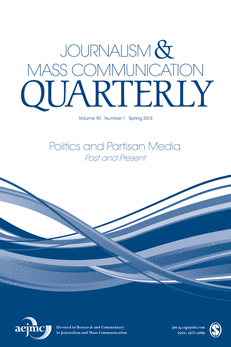
JOURNALISM & MASS COMMUNICATION QUARTERLY
Scope & Guideline
Fostering dialogue on the challenges of modern media.
Introduction
Aims and Scopes
- Interdisciplinary Approaches to Journalism Studies:
The journal embraces a variety of methodologies from different disciplines, including sociology, psychology, cultural studies, and political science, to analyze journalism's role and impact in society. - Focus on Media Effects and Public Perception:
Research often investigates how media framing, representation, and narratives shape public perception, trust, and engagement with news, particularly in the context of contemporary social issues. - Crisis and Conflict Reporting:
The journal frequently addresses the challenges and methodologies of reporting in crisis situations, such as wars, pandemics, and social movements, highlighting the ethical dilemmas faced by journalists. - Diversity and Representation in Media:
A consistent theme involves examining the representation of marginalized groups in media and the implications for social justice and equity, reflecting a commitment to promoting diverse voices in journalism. - Technology and Digital Media Influence:
The impact of digital technologies on journalism practices, audience engagement, and information dissemination is a critical area of study, with an emphasis on the challenges posed by misinformation and algorithmic biases.
Trending and Emerging
- Social Media's Role in Journalism:
Research increasingly examines how social media platforms influence news dissemination, audience engagement, and the construction of public narratives, reflecting the growing importance of digital communication. - Journalism and Activism:
There is a noticeable trend towards exploring the intersections between journalism and social movements, particularly how media can empower activism and influence public opinion on social justice issues. - Misinformation and Fact-Checking:
The rise of misinformation has led to a surge in studies focused on fact-checking practices, media literacy, and the role of journalism in combating false narratives, highlighting the urgency of these issues in the digital age. - Mental Health and Journalism:
Emerging research is increasingly addressing the mental health challenges faced by journalists, particularly in the context of high-stress reporting environments and the psychological impacts of covering traumatic events. - Innovative Storytelling Techniques:
There is a growing interest in how new technologies, such as virtual reality and data journalism, are reshaping storytelling in media, offering fresh perspectives on traditional journalistic practices.
Declining or Waning
- Traditional Journalism Ethics:
There seems to be a reduced emphasis on traditional ethics in journalism, as contemporary discussions increasingly focus on adaptive ethical frameworks that respond to digital challenges and misinformation. - Historical Perspectives on Journalism:
Research that primarily concentrates on historical analyses of journalism's evolution may be receiving less attention, as scholars prioritize current issues and future directions in the field. - Print Media and Its Challenges:
With the rise of digital media, studies specifically centered on print journalism's challenges and decline appear to be diminishing, as the focus shifts toward digital transformation and its implications. - Conventional Audience Research:
Traditional audience research methodologies, which often relied on quantitative measures of engagement, are less prevalent as qualitative and mixed methods gain traction in understanding audience behavior in a digital context. - Local Journalism Studies:
The exploration of local journalism issues may be declining, overshadowed by broader discussions about global media dynamics and the impacts of major national and international events.
Similar Journals
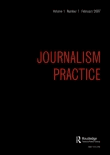
Journalism Practice
Connecting Theory and Practice in JournalismJournalism Practice is a leading peer-reviewed journal that serves as a vital platform for scholars and practitioners in the field of journalism and communication. Published by Routledge Journals under Taylor & Francis Ltd, this esteemed journal boasts an impressive impact factor and ranks in Q1 in the Communication category for 2023, highlighting its critical role in advancing knowledge and discourse within the industry. The journal covers the evolving practices, theories, and challenges in journalism and offers insight into the convergence of traditional and new media, having published comprehensive research articles from 2007 to 2013 and continuing from 2015 through 2024. Residing in the top 87th percentile in Social Sciences Communication (ranked #63 out of 511 in Scopus), Journalism Practice provides a rich source of information that is invaluable for researchers, professionals, and students seeking to engage with the latest developments in journalism. Although it is not an open-access journal, its curated content is essential for those committed to understanding and shaping the future of journalism.

Analisi-Quaderns de Comunicacio i Cultura
Advancing interdisciplinary dialogue in Communication and Cultural Studies.Analisi-Quaderns de Comunicacio i Cultura, published by Universitat Autònoma de Barcelona, is a distinguished open-access journal that has been serving as a pivotal platform for interdisciplinary research in Communication and Cultural Studies since its inception. With an ISSN of 0211-2175 and E-ISSN 2340-5236, this journal not only contributes significantly to its fields, as evidenced by its impressive rankings—Q2 in Communication and Q1 in Cultural Studies for 2023—but also boasts strong Scopus placements, including a rank of 181 out of 1304 in Cultural Studies. The journal's commitment to open access since 2010 ensures that research findings are readily available to a global audience, fostering collaboration among scholars, practitioners, and students. Located in Cerdanyola del Vallès, Barcelona, this publication invites contributions that explore the dynamic and rapidly evolving intersections of culture and communication, making it an essential resource for those seeking to advance knowledge and engage critically in these essential areas of study.

Media International Australia
Bridging Theory and Practice in Media ResearchMedia International Australia is a leading journal that occupies a unique position at the intersection of communication and cultural studies. Published by SAGE Publications Ltd, this journal has established itself as a vital platform for scholarly discourse since its inception, now converging efforts from 2008 to 2024. With an impressive Q1 ranking in both the Communication and Cultural Studies categories, it ranks 12th out of 1304 in Cultural Studies and 42nd out of 511 in Communication, placing it within the 99th and 91st percentiles respectively according to Scopus metrics. The journal is committed to providing access to rigorous research that reflects contemporary issues in media, making it essential reading for researchers, professionals, and students keen on advancing their understanding of media's role in society. Despite not being fully Open Access, it ensures that quality research remains accessible through institutional subscriptions, allowing a broad audience to benefit from its insightful contributions.

Jurnal Komunikasi-Malaysian Journal of Communication
Fostering Scholarly Discourse in a Digital AgeJurnal Komunikasi-Malaysian Journal of Communication is a premier, peer-reviewed journal published by the NATIONAL UNIVERSITY OF MALAYSIA, FACULTY OF SOCIAL SCIENCES & HUMANITIES. With an ISSN of 2289-151X and an E-ISSN of 2289-1528, this journal focuses on diverse aspects of communication theory and practice, particularly within the Malaysian context. As a significant contributor to the field, it has established itself with a respectable impact factor and currently holds a Q3 ranking in the Communication category per the 2023 Scopus Quartiles. The journal is dedicated to fostering scholarly discourse and advancing knowledge in communication studies, encompassing an array of topics from interpersonal communication to mass media impact. Since its inception, it has been committed to maintaining high academic standards while providing an engaging platform for researchers, professionals, and students. With converged years from 2014 to 2024, Jurnal Komunikasi continues to address emerging trends and challenges in communication, making it an invaluable resource for those seeking to deepen their understanding and engagement with the discipline.
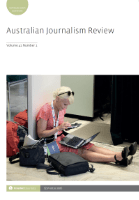
Australian Journalism Review
Exploring the Evolution of Journalism in AustraliaAustralian Journalism Review, published by INTELLECT LTD, is a leading academic journal that focuses on the dynamic field of journalism and communication. With the ISSN 0810-2686 and E-ISSN 2517-620X, this journal has established itself as a significant contributor to understanding contemporary journalism in Australia and beyond. It boasts a respectable Q2 ranking in the Communication category for 2023, positioning it among the top journals in its field, with a Scopus rank of #273 out of 511 in Social Sciences Communication, reflecting its growing impact within academic and professional circles. The journal’s scope includes critical analyses of journalism practices, media policy, and the evolving roles of journalists in society, making it an essential resource for researchers, professionals, and students interested in the intersection of media, ethics, and culture. Although it does not currently offer open access, interested audiences can find valuable insights from its converged issues, spanning from 2003 to 2024, allowing for a comprehensive view of the progression and transformation of journalism studies.

IC-Revista Cientifica de Informacion y Comunicacion
Unveiling New Perspectives in Library and Information SciencesIC-Revista Cientifica de Informacion y Comunicacion, published by UNIV SEVILLA, EDITORIAL, stands at the forefront of academic discourse in the fields of Communication, Cultural Studies, Library and Information Sciences, and Linguistics and Language. With its ISSN 1696-2508 and E-ISSN 2173-1071, this esteemed journal showcases high-quality research, contributing significantly to the advancement of knowledge since its inception in 2016. The journal is recognized for its rigorous standards, holding a Q2 category in Communication, a Q1 category in Cultural Studies, as well as Q2 rankings in both Library and Information Sciences and Linguistics and Language as of 2023. With a growing reputation, it is ranked in the mid percentiles across various Scopus categories, marking it as a key player in its spheres of influence. Although not an open-access journal, it remains accessible through institutional subscriptions, making it a vital resource for scholars and practitioners alike. The editorial team is dedicated to fostering innovation and engagement within the academic community, aligning with the evolving dynamics of information and communication.
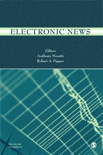
Electronic News
Advancing Knowledge at the Intersection of Communication and Innovation.Electronic News, published by SAGE PUBLICATIONS INC, stands at the forefront of scholarly communication, focused on the dynamic intersection of media, technology, and society. With an ISSN of 1931-2431 and an E-ISSN of 1931-244X, this journal has established itself as a valuable resource for academics and professionals alike, exploring critical themes in communication and information systems. Operating from its base in the United States, Electronic News operates within a competitive landscape, boasting a commendable Q2 ranking in Communication and a Q3 ranking in Information Systems. This reflects its commitment to high-quality research and impactful insights, as evidenced by its Scopus rankings, where it ranks #238 out of 511 in Social Sciences Communication and #302 out of 394 in Computer Science Information Systems. Although currently embracing a traditional subscription model, the journal serves as a crucial platform for disseminating knowledge that shapes the future of news and media in a rapidly evolving digital age. As it converges from 2009 to 2024, Electronic News continues to invite contributions that address the multifaceted challenges and innovations of news media, making it an essential resource for researchers, practitioners, and students eager to engage with contemporary issues in communication.

Communitas
Cultivating Critical Discourse in a Global ArenaCommunitas, published by the University of the Free State, is an esteemed open-access journal that has been a gateway for innovative research and discourse in the fields of communication, linguistics, and language since its inception in 2017. With an ISSN of 1023-0556 and E-ISSN of 2415-0525, the journal aims to foster scholarly exchange by providing a platform for critical analysis and interdisciplinary collaboration. Although it currently falls into Q4 in Communication and Q3 in Linguistics and Language, *Communitas* has made significant strides in establishing its presence in Scopus rankings—ranking 567 out of 1088 in Arts and Humanities and 397 out of 511 in Communication—and sources for researchers at varying stages of their careers. Addressed to a global readership, the journal invites contributions that enhance understanding and generate new perspectives on socio-linguistic issues and communicative practices, making it a pivotal resource for researchers, academics, and students committed to advancing knowledge in these dynamic fields.
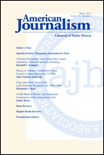
American Journalism
Examining the Multifaceted World of Journalism.American Journalism is a prominent peer-reviewed journal dedicated to advancing the field of communication, with a particular focus on the evolving landscapes of journalism practices and media studies. Published by Routledge Journals, Taylor & Francis Ltd, this journal serves as a critical platform for researchers, professionals, and students aiming to explore the multifaceted dimensions of journalism from 1983 to the present. While it currently holds an impact factor ranking within the Q4 category of communication disciplines, its commitment to publishing innovative research and fostering dialogue ensures it remains an integral resource for understanding contemporary media dynamics. With its address in the heart of the United Kingdom, the journal upholds a global perspective, engaging with diverse issues relevant to today's journalistic environment. Although it does not provide open access options, the journal offers access through various academic libraries and institutional subscriptions, making it a valuable asset for anyone invested in the future of journalism.

Revista de Comunicacion-Peru
Exploring the Frontiers of Communication Studies.Revista de Comunicación-Perú is a distinguished open-access journal published by Universidad de Piura, with a dedicated focus on communication studies. Since its inception in 2002, the journal has provided a vital platform for researchers, professionals, and students to disseminate knowledge and foster discourse in the field of communication. As of 2023, it proudly holds a Q1 classification in the Communication category and ranks impressively in Scopus, placing at #117 out of 1304 in Cultural Studies and #160 out of 511 in Communication, demonstrating its significant impact within the academic community. The journal’s scope encompasses diverse topics related to communication, cultural discourse, and media analysis, making it an essential resource for those seeking to explore contemporary issues in these areas. With a commitment to promoting scholarly exchange, Revista de Comunicación-Perú continues to play a pivotal role in shaping the communication landscape in Peru and beyond.